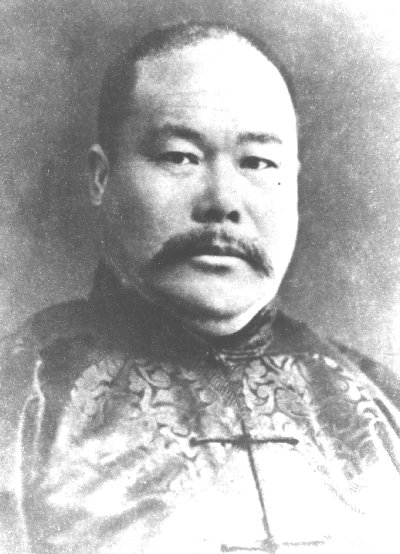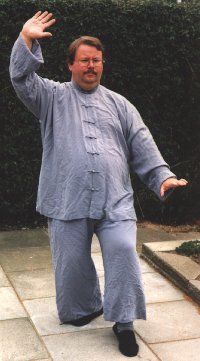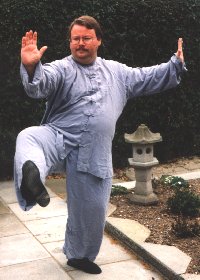Yang Chengfu |
||
|
In my youth I used to see my late grandfather, Yang Lu-Chan, lead my perternal uncles and other students in daily practice of Tai Chi Chuan. They trained day and night without rest, both individually and in pairs. I was skeptical, however, believing self-defense against one man was not worth studying, and that in the future, I would study defense against ten thousand. After I was a bit older, my late uncle, Yang Pan-hou, bid me study with him. As I could no longer conceal my doubt, I expressed them to him directly. My late father, Chien-hou, became angry and said, "Well now, what kind of words are these? Your grandfather bequeathed this to our family. Do you propose to discard our family heritage?" My late grandfather, Lu-chan, calmed him and saying, "Children should not be coerced." He gave me a gentle pat and continued,"Hold on for a minute and let me explain. The reason I practice and teach this art is not to challenge others but for self-defense, not to bully the world but to save the nation. The gentlemen of today know only of the poverty of the nation, but not of its weakness. Therefore our leaders anxiously formulate policies to alleviate poverty, but I have never heard of plans to rouse the weak or raise up the ailing. With a nation of sick people, who is equal to the task? We are poor because we are week; truly weakness is the cause of poverty. If we examine the rise of nations, we find that they all begin by strengthening the people. The virility and vigor of the Europeans and Americans goes without saying, but the dwarf-like Japanese, while short in stature, are disciplined and determined. When the gaunt and emaciated members of our race face them, one need not resort to devination to predict the outcome. Thus the best method of saving the nation is to make saving the weak our highest priority. To ignore this is to be doomed to failure. From my youth I have always considered helping the weak as my personal responsibility. I have seen popular martial arts performers whose spirit and physique are in no way inferior to the so-called muscle men of the West. With great enthusiasm I begged to learn their art, but they kept it secret and would not tell me. In this way I discovered that China's possessing the art of physical health and yet having become so weak is not without cause. Still later I heard that at Ch'en-chia-kou in Honan there was a Ch'en family who were famous for their internal boxing and I made immediate haste to go there and study with Ch'en Ch'ang-hsing. Although I was not turned away at the door, after a long time I was still not allowed to share their secrets. I forbore and was patient for more than ten years. My teacher was moved by my sincerity and began, in the evenings when everyone else was resting, to reveal the secrets to me. After completing my studies I came to the capital and swore an oath to teach this art freely to all comers. Before long I saw that among my students, the thin filled out, the obese lost weight, and the sick became healthy. I was enormously gratified. It seemed to me that what one individual could teach was limited and very like the foolish old man who tried to move the mountain. Also would not those of my elder's generation and those whose ambition was to play the bully look down upon this method of saving the nation and choose not to study it?" At that moment I came suddenly to appreciate my grandfather's diligence in respect to this art and from then on dedicated myself to carrying on the family transmission. I eagerly submitted myself to training. My grandfather had handed down these words:"Tai Chi Chuan began with Chang San-feng at the end of the Sung dynasty. He transmitted it to Wang Tsung-yueh, Ch'en Chou-t'ung, Chang Sung-hsi and Chiang-Fa, who succeeded each other without interruption. My teacher, Ch'en Ch'ang-hsing, was the only disciple of Chiang-Fa. His art was based on the natural, and its form never departed from the Great Ultimate. It consisted of thirteen postures with infinite applications. The movement is in the body, but the influence reaches the spirit. Thus, without long practice, it is difficult to achieve the highest level. I have no shortage of students, but as for those who have been tempered to absolute perfection,I cannot even be certain of Pan-hou. However, if we speak only of the science of health, then one day's effort produces one day's benefit, and one year, one year's results. If you understand this, my child, then you possess the means to carry out my ambition." I respectfully observed his words and never dared forget them. From this point forward, I worked without ceasing for twenty years. My grandfather, uncle and father passed away one after the other. At first I began to accept students in Peking (Beijing) but felt confined and limited in my results, so I traveled south to the Fukien-Chekiang region between the Yangtze and Huai Rivers. I later asked my student, Ch'en Wei-ming, to publish a book based on my oral instructions. Now ten years later, Tai Chi Chuan has spread north and south of the Yellow River and east and west of the Yangtze, even as far as Kwangtung Province. Altogether there are a great numbers of students. Ch'en's book explains only the sequence of solo practice, and looking back at the photographs of my postures ten years ago, they are inferior to today's. From this it can be seen that this art will continue to evolve indefinitely. Today, at the request of my students, I have once again compiled the complete method of principles and applications, and added new photographs throughout. I have committed this to print in order to share it with the world. The techniques for two-edged sword, spear, two-pronged spear, broadsword, and so forth will be presented in a second volume to follow. I do not dare to seek fame through my art but humbly desire to further my forebear's ambition to rouse the people and save the world.
Written by Yang Chiao Ching (Chengfu) of Kuanping in the Spring of 1933.
The names of the movements in Yang Style Tai Chi Chuan
1. Preparation - Yu bei Shi Back to the beginning of this page ©1998 Knud Erik Andersen |
||



